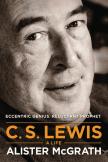What to Do About Religion and Culture
It began innocently enough. An anxious evangelical graduate student trying to reconcile Christian humility with intellectual pride through the study of C. S. Lewis. A kindly professor devising an independent reading course, which turned into a seminar, then a large class, finally a slender book.
Wesley A. Kort, a professor in the department of religion and a member of the graduate faculty of religion at Duke University, is the Lewis-like professor, and no doubt he too is the proud possessor of a wardrobe with unusual properties. To his credit he has used Lewis, not as a Jeremy Bentham-like figure, stuffed and leathery, produced once a year to preside at a meeting at University College London, but as a historical figure who has much to say in the present discussion of culture.
According to Lewis, old culture had produced enchantment. According to Kort, modern culture has produced disenchantment. Hence, this rather tart Lewis-Kort statement: America is like Narnia, a place under the spell of the wicked witch who brings only winter and never Christmas.
In reading a dour and sour argument like this, I found Kort a diffident gardener pottering about the Kilns (Lewis’s home for much of his adult life), but in the third chapter, Houses, Kort became absolutely thrilling. He had penetrated Lewis’s world in a way that few before him have. Everywhere in Lewis’s life and writings, there are houses of all sorts, spaces of all dimensions. Even Christianity is a sort of house, a large and complex house [that] also serves to accommodate the variety within Christian practices and beliefs.
Now Kort is on the inside of the Kilns, talking like an architectural historian and, I must say, getting everythingliterarily, intellectually, mysticallyright!
Two chapters later he dazzles again, resolving into a dew what Lewis thought about culture and Christianity. The relation between the cardinal and the theological virtues resembles the relation between culture and a Christian account of the world. As saintliness depends upon character formation, so a Christian account of the world depends upon a viable culture. As saintliness is something very different from character formation yet depends on it, so Christianity is very different from culture but also requires it.
In the last chapter of his book, Kort presents a sketch for the retrieval and reconstruction of a more viable culture and [his] call for beginning a Lewis-like project on our shores. Also he would like his Lewisian model to be considered by his peers in the graduate schools of America as a viable model, one of perhaps many, for confronting the cultural crises of our day.
Having challenged both religious tendencies to live increasingly in rejection of culture and the tendencies of culture theory and criticism to discount or distrust religion, Kort has indeed achieved his modest aim.
That is not to say that, under the sway of Lewis and Kort, either the Narrow Audience of academic intellectuals or the Wider Audience of evangelical readers will be any the happier. The evangelicals won’t be able to put Christianity and culture back together againthat is to say, to slap some biblical stickum on Humpty Dumpty, then hang his jolly figure from their rearview mirrors.
Nor will the academic intellectuals anytime soon be wearing trendy sweatshirts bearing Lewis’s sapiential words, Poor boob, he thought his mind was his ownNever his own until he makes it Christ’s!
By book’s end, the author has not presented a necessary next step. Perhaps there is noneperhaps only some critiques from his peers. Perhaps later a curriculum based on Lewis’s works. I wish Kort well on his daunting if dithering venture.
Throughout C. S. Lewis: Then and Now Kort makes selective use of Lewis’s published materials but almost no use of the several Lewis biographies. I am not sure they would have enriched his study, but they would have revealed several further clues to Lewis’s attitude toward modern culture. Permit me to offer one example.
In the 1930’s Lewis and his brother enjoyed listening to classical music on BBC Radio every Sunday evening, but when asked to go on the radio himself, we could have expected the Oxford professor of medieval and renaissance literature to say no. But he said yes. Once he said yes, he had to get his topic approved and bend to the requirements of this scratchy mediumwhich meant having to dumb down his usual rhetoric and being censored as to content and scissored as to length. Perhaps worse, he had to go to London during the Blitz to do the broadcasts. Worst of all, his usual time slot was late Sunday night, when everybody was asleep.
The result? The first series of talks prompted three more. Each produced a modest book. All four combined turned into the bestseller Mere Christianity.
The point here is not that the work has become a staple on bestseller lists even to this day. The point is that when confronted with an entrance point into the culture of his day, if I may borrow a slogan from our own day, he just did it!
And so he did, throughout his life, with shocker plays à la Frankenstein, children’s literature à la Tolkien, science fiction à la Arthur C. Clarke, comic poems in Punch and a silly epistolary novel about two devils trying to tempt a bloke in the British Museum, of all places. Perhaps a stage version of this, a film of that. Some succeeded; others failed.
But since that time, with no other model than Lewis himself, any number of Christians have been doing the same thingentering the culture and making it their own. An annotated Lewis bibliography at the end of the book would have been nice.
This article also appeared in print, under the headline “What to Do About Religion and Culture,” in the December 10, 2001, issue.








